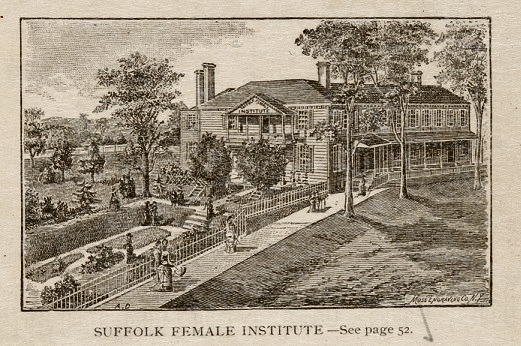Located in Suffolk, Virginia and chartered in 1881, the Suffolk Female Institute was run by Misses Sallie Finney in what had once been the Central Hotel and offered a “thorough education. . .correct moral training and proper social cultivation” to “young ladies and little girls” for $160.00 per year. “The Corps of teachers is efficient and experienced,” an 1886 ad for the school explained, “The home training, moral and attractive. Fine advantages in music, art and languages, at moderate rates.”
Like many schools, the Suffolk Female Institute, in operation from 1869-1908, published its own newspaper, the Casket. Where the title came from is anyone’s guess, but the content of the paper was not so macabre (actually, “Casket” had a not-so-macabre meaning in the 1800s–for an explanation, see Bill Bynum’s comment below). Poetry, personals, jokes, student news, alumni updates, homilies, the latest fashion trends and advertisements made up a typical issue, which was free to students and five cents for everyone else. Of course, sometimes the news could be melancholy: “A sudden death,” announced one headline, “Died at Suffolk Female Institute, Dec. 3d., 1877, little Frank, Miss Mattie’s darling little bird. We will all miss little Frank very much. We will no more be awakened from our slumbers by his sweet singing. He has sung his last song, and left us to mourn his loss.”
Thanks to generous patron Joe Neagle, the Library of Virginia now has four issues of the Casket on microfilm and one original copy. The papers, dating from 1878-1879, were originally collected by his great-grandmother while she attended the school. Mr. Neagle saved the papers and brought them to the Library of Virginia where they were microfilmed by the Virginia Newspaper Project.
The Casket is a rare gem of women’s history and offers insight into the preoccupations of girls and young women at a time when education was a luxury and expectations for women didn’t often extend outside the domestic sphere. While the papers were written in a very different world, they also demonstrate that the more things change, the more they stay the same. A great addition to the Library’s collection in their own right, the four issues enhance other resources available at LVA about the Suffolk Female Institute including a register of students in the Kilby family papers. The Southampton Historical Society archives also has class photos and an 1874-1875 school catalog in its collection.
Mr. Neagle’s collection didn’t stop with the Casket–He also loaned LVA four issues of The Institute Jewel, published by the students of the Suffolk Collegiate Institute, presumably collected by his great-grandmother while she attended the school in 1880. Like the Suffolk Female Institute, the Suffolk Collegiate Institute encouraged good moral and educational instruction, but unlike it’s counterpart, it believed that a co-ed environment was the key to a well rounded experience. “Girls and young ladies recite with classes in the Male Dept.,” it explained, “as we think when sexes are educated together, it creates a generous rivalry which results in more refined and polished manners and in a higher order of intellectual attainment.”
The Suffolk Collegiate Institute’s newspaper had a size and look very similar to that of the Casket. The Institute Jewel also included like content with local and student news, cultural news, poetry, religious anecdotes, excerpts from other newspapers, and lessons on the virtues of healthy and honorable living. One article, titled “A True Lady,” touted the virtues of a working woman. “We have learned,” the article explained, “that the woman who works in some honorable way to maintain herself, loses none of the dignity nor refinement of true womanhood, and is just as much, even more, an ornament to her sex than the woman whose days are passed in indolence.” The subscription rate was a bit less for the Jewel at twenty cents for six months and thirty cents per year.
The Institute Jewel, like the Casket, offers unique and valuable historic insight into the late nineteenth century from the perspective of young people. Before the eight issues were brought to the Library of Virginia, no other extant copies were available. Now, both The Institute Jewel and the Casket are available on microfilm (Film #2585). Look for them on soon on Virginia Chronicle, the Library’s digital newspaper database.












The title “Casket” is not really macabre; the word is being used in its original meaning of “jewel box” (hence, a container for literary “gems”). In 1869, Americans were just starting to use “casket” as a euphemism for “coffin.”
The first time I saw the papers, I thought it was an odd name for any kind of newspaper. Then I thought there had to be a different meaning to the word at that time. The name of the second paper, “The Institute Jewel”, suggests that also.